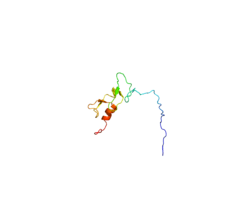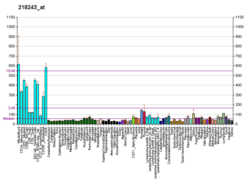RUFY1
RUN and FYVE domain-containing protein 1 is a protein that in humans is encoded by the RUFY1 gene.[5][6] It is named after the RUN and FYVE domains it contains.
Interactions
RUFY1 has been shown to interact with BMX.[5]
gollark: Also, there are exploits in the wild.
gollark: If the `uninstall` command is too complex for you, that is your fault.
gollark: You can uninstall it easily.
gollark: Oh, and user accounts. That could be fun.
gollark: Do you want me to implement a separate computer name system?
References
- ENSG00000176783 GRCh38: Ensembl release 89: ENSG00000284260, ENSG00000176783 - Ensembl, May 2017
- GRCm38: Ensembl release 89: ENSMUSG00000020375 - Ensembl, May 2017
- "Human PubMed Reference:". National Center for Biotechnology Information, U.S. National Library of Medicine.
- "Mouse PubMed Reference:". National Center for Biotechnology Information, U.S. National Library of Medicine.
- Yang J, Kim O, Wu J, Qiu Y (Aug 2002). "Interaction between tyrosine kinase Etk and a RUN domain- and FYVE domain-containing protein RUFY1. A possible role of ETK in regulation of vesicle trafficking". J. Biol. Chem. 277 (33): 30219–26. doi:10.1074/jbc.M111933200. PMID 11877430.
- "Entrez Gene: RUFY1 RUN and FYVE domain containing 1".
Further reading
- Cormont M, Mari M, Galmiche A, Hofman P, Le Marchand-Brustel Y (2001). "A FYVE-finger-containing protein, Rabip4, is a Rab4 effector involved in early endosomal traffic". Proc. Natl. Acad. Sci. U.S.A. 98 (4): 1637–42. doi:10.1073/pnas.031586998. PMC 29309. PMID 11172003.
- Fouraux MA, Deneka M, Ivan V, van der Heijden A, Raymackers J, van Suylekom D, van Venrooij WJ, van der Sluijs P, Pruijn GJ (2004). "Rabip4' is an effector of rab5 and rab4 and regulates transport through early endosomes". Mol. Biol. Cell. 15 (2): 611–24. doi:10.1091/mbc.E03-05-0343. PMC 329268. PMID 14617813.
- Suzuki Y, Yamashita R, Shirota M, Sakakibara Y, Chiba J, Mizushima-Sugano J, Nakai K, Sugano S (2004). "Sequence comparison of human and mouse genes reveals a homologous block structure in the promoter regions". Genome Res. 14 (9): 1711–8. doi:10.1101/gr.2435604. PMC 515316. PMID 15342556.
- Rual JF, Venkatesan K, Hao T, Hirozane-Kishikawa T, Dricot A, Li N, Berriz GF, Gibbons FD, Dreze M, Ayivi-Guedehoussou N, Klitgord N, Simon C, Boxem M, Milstein S, Rosenberg J, Goldberg DS, Zhang LV, Wong SL, Franklin G, Li S, Albala JS, Lim J, Fraughton C, Llamosas E, Cevik S, Bex C, Lamesch P, Sikorski RS, Vandenhaute J, Zoghbi HY, Smolyar A, Bosak S, Sequerra R, Doucette-Stamm L, Cusick ME, Hill DE, Roth FP, Vidal M (2005). "Towards a proteome-scale map of the human protein-protein interaction network". Nature. 437 (7062): 1173–8. doi:10.1038/nature04209. PMID 16189514.
- Kimura K, Wakamatsu A, Suzuki Y, Ota T, Nishikawa T, Yamashita R, Yamamoto J, Sekine M, Tsuritani K, Wakaguri H, Ishii S, Sugiyama T, Saito K, Isono Y, Irie R, Kushida N, Yoneyama T, Otsuka R, Kanda K, Yokoi T, Kondo H, Wagatsuma M, Murakawa K, Ishida S, Ishibashi T, Takahashi-Fujii A, Tanase T, Nagai K, Kikuchi H, Nakai K, Isogai T, Sugano S (2006). "Diversification of transcriptional modulation: large-scale identification and characterization of putative alternative promoters of human genes". Genome Res. 16 (1): 55–65. doi:10.1101/gr.4039406. PMC 1356129. PMID 16344560.
This article is issued from Wikipedia. The text is licensed under Creative Commons - Attribution - Sharealike. Additional terms may apply for the media files.





